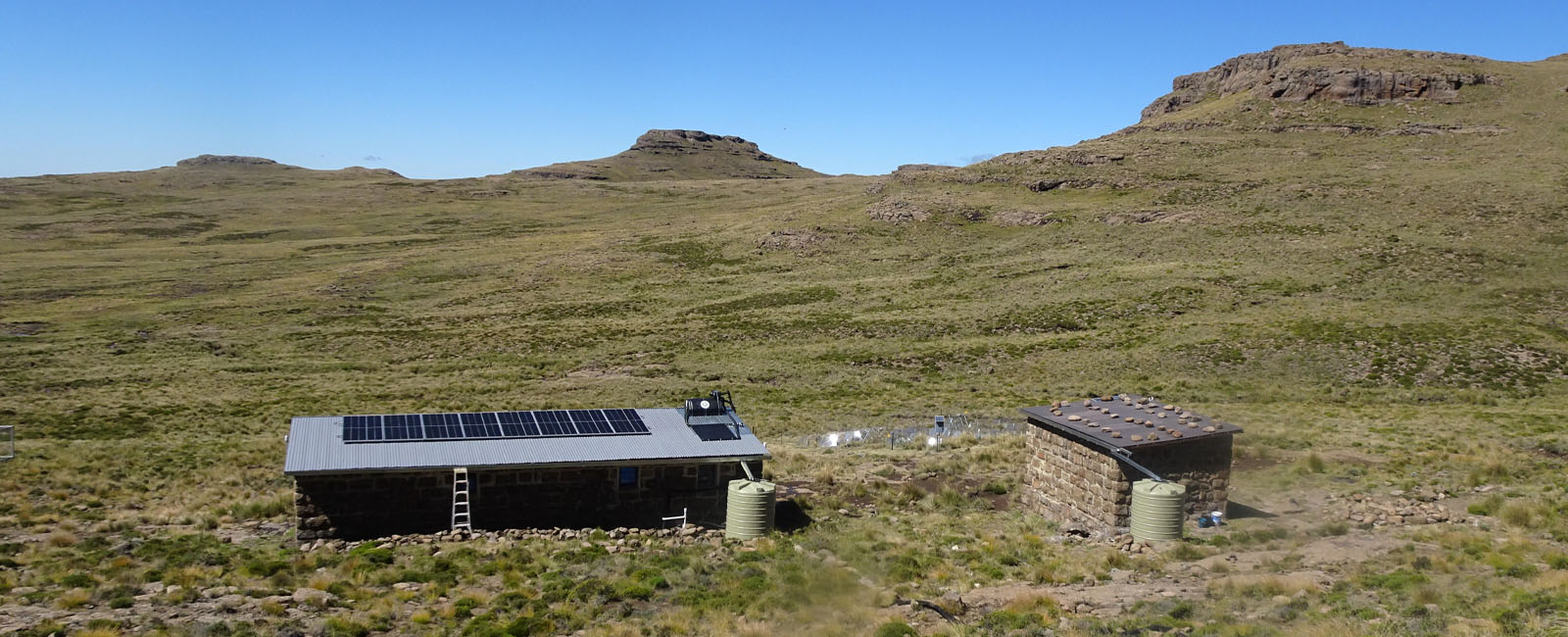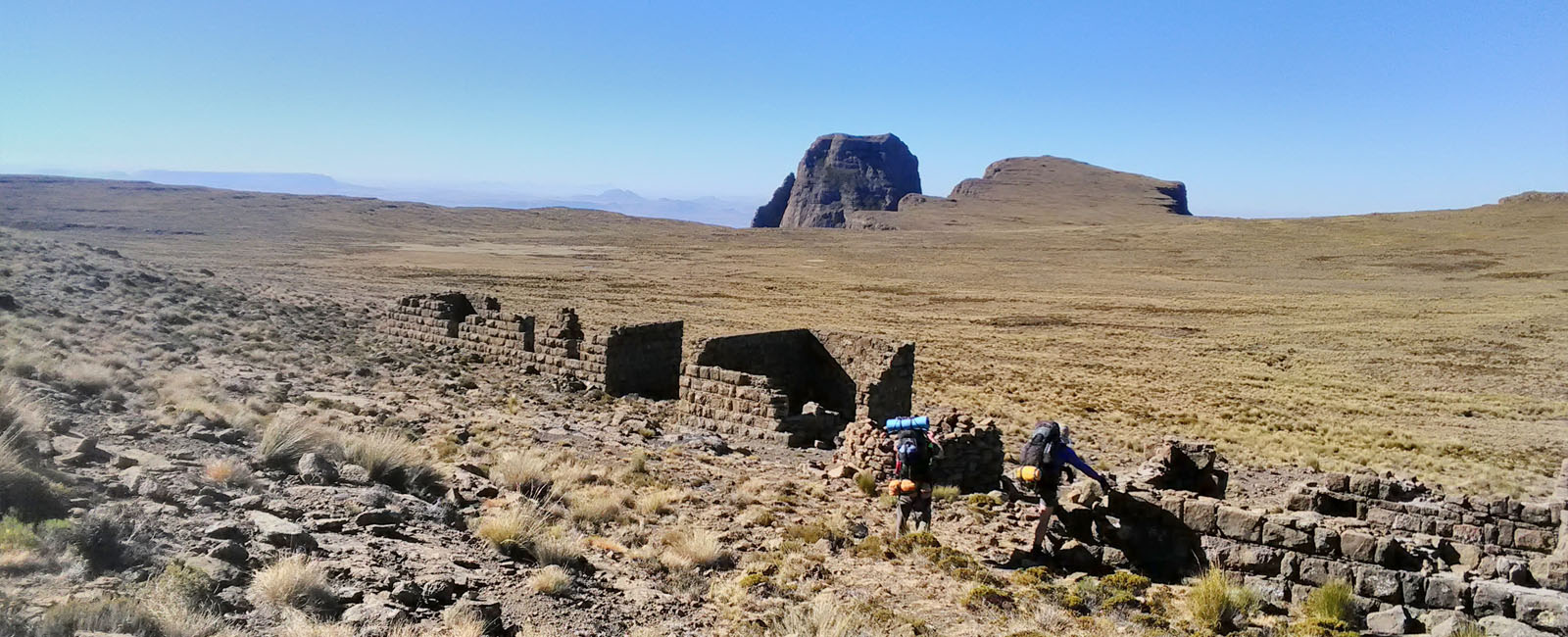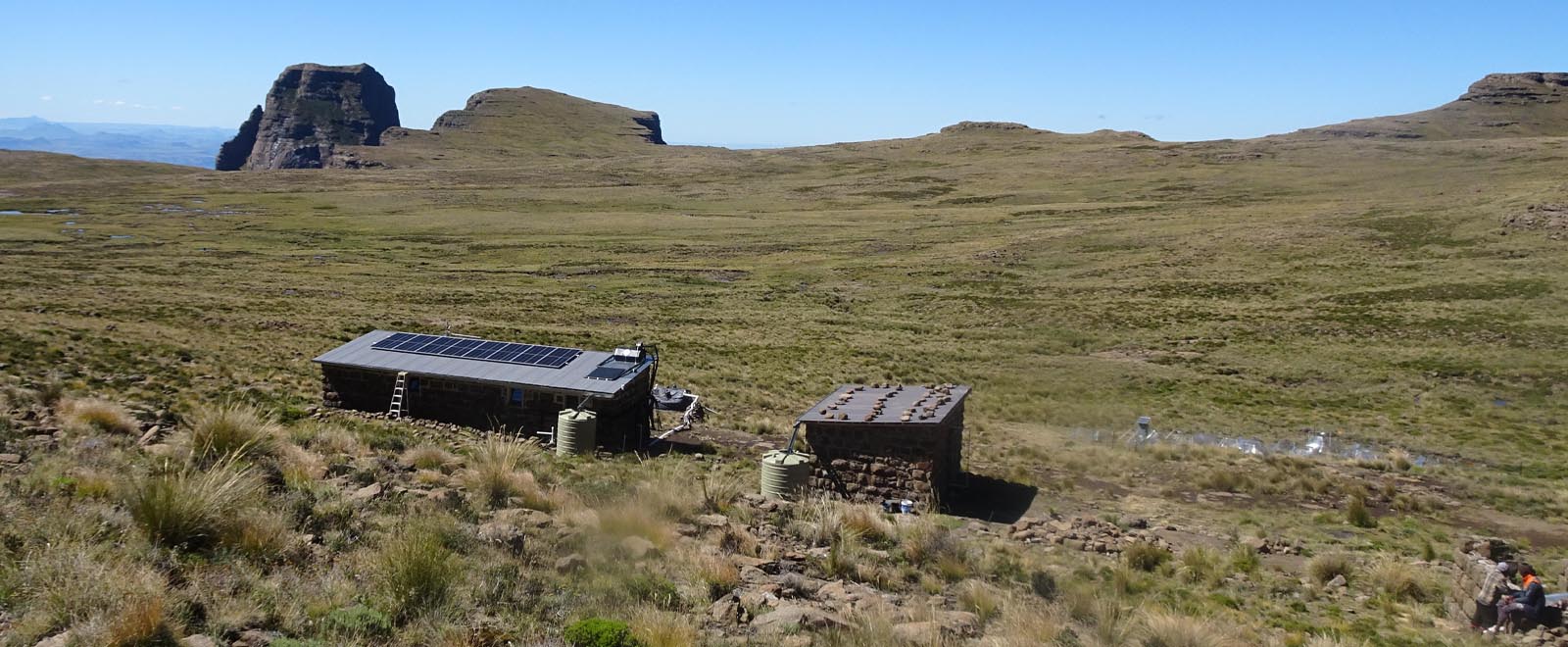Witsieshoek-ARU Alpine Base

The Witsieshoek-ARU Alpine Base with Crow’s Nest Peak (KwaZulu-Natal) in the left background, and the Mont-aux-Sources ridge (South Africa-Lesotho border) in the right background.
Witsieshoek-ARU Alpine Research Base
The Witsieshoek-ARU Alpine Research Base (28o45'17"S 28o52'00"E) currently comprises two resurrected buildings of the three original Namahadi Police Border Post buildings, situated at 3 069 m – at the head of the Namahadi Pass – in the Free State (Qwaqwa Maloti) component of the Maloti-Drakensberg, South Africa.
The base is the highest-elevation research facility in Africa, the highest tourist mountain hut in Southern Africa, and the 21st highest mountain hut in Africa. In the Maloti-Drakensberg, it is higher than the facilities at AfriSki, Bokong Nature Reserve, Sani Top, Sehlabathebe National Park, or the Mountain Club of South Africa’s (MCSA) hut on the Amphitheatre (2,5 km away to the east in a direct line). The nearest higher mountain hut is on Mt Kilimanjaro (some 3 000 km to the northeast).
The base is located 1,5 km (in a direct line) west-south-west of the chain ladders in the Elands/Vemvaan stream alpine catchment; this stream feeds the Elands waterfall that flows over the escarpment close to the chain ladders (and features on the cover of Elsa Pooley’s Mountain Flowers book). The uThukela (Tugela) Falls – now considered the highest in the world – is located only 2,7 km (in a direct line) east of the base.
The base provides easy access to the Namahadi cutback and environs (via Namahadi Pass), as well as to the highest peak in the Free State – Namahadi Peak (3 292 m; about six km to the west-south-west in a direct line). It also provides a good start or end point for those doing the Qwaqwa Maloti Traverse (Witsieshoek to Monontsha), or along the KZN Drakensberg (e.g. the Grand Traverse). It also provides a nearby overnight option for those who want to spend more time on Mont-aux-Sources Peak (3 282 m; 2 km south in a direct line).
Background
The original Namahadi Police Border Post buildings were erected in 1917 to serve as a border post for foot and bridle traffic between South Africa and Lesotho. The original buildings were extensively vandalised and left in ruins for many decades. It is not known how long the buildings lay in ruins, but likely for more than 50 years. If only ruins could talk … but Reg Pearce provides some interesting history of this Free State summit area in his book Barrier of Spears.
In 2020, the Afromontane Research Unit (ARU) ‘discovered’ the ruins and began the process of negotiating with Transfrontier Parks Destinations/Witsieshoek Mountain Lodge for the resurrection and use of these ruins as South Africa’s first alpine research facility. This is due to the proximity of the UFS Qwaqwa Campus to Witsieshoek, the need for secure alpine facilities for international projects such as ‘RangeX’, and the urgent need for an alpine research programme in the Maloti-Drakensberg, given the possible extinction of the alpine system from climate change in coming decades.
The process of resurrecting two of the three ruins was accomplished by May 2022 (middle building) and May 2023 (largest building) through financial support from the Department of Science and Innovation and the National Research Foundation’s Risk and Vulnerability Science Centre programme to the ARU. The original stone was placed back into the walls. All other materials were either flown in by helicopter or portered up via the chain ladders. The total cost of the project to date has been around ZAR 1 million. The project was implemented by BNQ Services (Pty) Ltd, with aviation support by BergFlying (Westline Aviation).

The old Namahadi Police Border Post ruins in July 2020 with Sentinel Peak and the Western Buttress in the mid-background (left and right of each other respectively).

The Witsieshoek-ARU Alpine Base.
The base is located on land that is under a 7 000-ha long-term lease from the Batlokoa Traditional Authority to Transfrontier Parks Destinations for the management of the Witsieshoek Mountain Lodge and associated mountain recreation. The UFS has sub-leased the alpine component of this area, covering some 250 ha, being the summit areas that are bounded by the boundary with KwaZulu-Natal (Royal Natal National Park – uThukela alpine catchment), the international border with Lesotho (Mont-aux-Sources ridge), and the Free State escarpment edge (from the chain ladders west to the Namahadi cutback). The sub-lease agreement leaves the base in the management hands of Transfrontier Parks Destinations/Witsieshoek Mountain Lodge (including management and maintenance), but with preferential use by the ARU. The model allows the base to also be used for commercial (tourist) purposes to offset expenses related to maintaining such a facility in the extreme conditions of the high Drakensberg, including security. Security costs to date have been covered by ETH Zurich as part of the ‘RangeX’ collaboration.
Traditional challenges for long-term alpine research in the Maloti-Drakensberg are security, access logistics, and the extreme conditions. The base project has overcome all three of these. For more information on alpine projects around the base (including ‘RangeX’), please see the Mont-aux-Sources LTSER tab on the ARU website.
Facilities
- The base currently provides basic shelter in the form of a large building that can accommodate up to 20 people sleeping on the floor.
- The building has an insulated ceiling and floor, and double-glazed windows. However, temperatures at the base can drop below freezing at any time of the year and the building can still be very cold. Users should make sure that they have enough warm gear. The mean annual temperature at the base is probably around 6 oC.
- There are no bunks or cooking facilities, and users must bring everything they need for their own use.
- Indoor lighting is provided through solar power.
- There is a basic bathroom (toilet, shower) with a specially designed alpine sanitation treatment system (due to the extreme conditions).
- Water is supplied through tanks from roof-collected rainwater/snowmelt; water is abundant is summer, but scarce in the dry season (additional water may need to be brought in the winter and spring). In winter, the system may be frozen due to the extremely low temperatures.
- The Vemvaan/Elands stream is not a reliable source of water in the dry season (May to October, or until the rains come), and due to livestock faeces in the catchment area (from seasonal Basotho grazing) it is not recommended for human consumption without boiling/purifying.
- The smaller building houses the security guards, who look after the base and associated research equipment.
- Visitors must please take all their rubbish back with them, as the logistics of bulk refuse removal by Witsieshoek Mountain Lodge from multiple visitors is impractical and risky for the local environment in this context.
Bookings and Rates
Income generated by the use of the base goes directly towards security, insurance, logistics, and maintenance – given the extreme conditions of the high Drakensberg (high winds, low temperatures). This is necessary to ensure that the base is a viable long-term proposition and does not go the way of the MCSA’s mountain hut on the Amphitheatre. A viable base will ensure sustainable long-term research in one of South Africa’s most poorly known ecological contexts.
Bookings for the use of the base (for research and other) can me made via Transfrontier Parks Destination’s Trade Reservations office – Devonia de Koker reservations@witsieshoek.co.za
- All booking requests should be in writing (email) for Witsieshoek Mountain Lodge to be able to track and report on usage. Online booking functionality may be added in the future.
- Bookings open 11 months in advance.
- The first three days of each month will be exclusively for ARU Research Champions and ARU Research Fellows to book before any commercial bookings are made. This does not mean that the ARU team cannot book at a later stage, but they will always have first option on availability.
- On booking, Witsieshoek Mountain Lodge will provide a detailed fact sheet about the base’s facilities, what there is and what not. It will also explain the presence of the security guards, their role and responsibilities, and also what they do not do.
Rates are structured as a tiered system:
- TIER 1 – ARU Research Champions and ARU Research Fellows and their immediate (UFS-registered) postgraduate students and postdoctoral research fellows use the base free of charge. Entry gate and hiking fees are waived.
- TIER 2 – Non-ARU UFS academic staff, postgraduate students and postdoctoral research fellows have a rack rate of ZAR495 per person per night with 20% discount = ZAR396 per person per night. Entry gate and hiking fees are waived.
- TIER 3 – Non-academic and external (non-UFS) academic bookings have a rack rate of ZAR595 with 20% discount = ZAR476 as an ‘overnight at the alpine base’ rate. Entry gate and hiking fees apply.
- TIER 4 – Exclusive access to the alpine base (i.e. no other bookings for the same night) –a minimum payment of ZAR5 000 per night. Entry gate and hiking fees apply.
- TIER 5 – Groups of more than 16 people will need to bring tents to supplement space at the base and will be charged a venue hire fee of ZAR5 000. Entry gate and hiking fees apply.
Research projects
Research projects by non-ARU UFS and non-UFS academics in the alpine lease area are encouraged. These are charged at ZAR5 000 per year. Projects need to be logged with the ARU Director, Prof Ralph Clark (clarkvr@ufs.ac.za), prior to implementation to ensure that there is capacity for this (e.g. security management on site), no/limited risk or damage to the environment, and that Witsieshoek Mountain Lodge approval is granted. All other relevant permits and ethical clearance would need to be in place.
Safety
A safety briefing prior to visiting the base is recommended for those who are not familiar with the dangers of the high Drakensberg (mist, sudden changes in weather, lightning).
Essentials are:
- Check the weather report and prepare accordingly, especially if a cold front or wet weather is forecast.
- Have enough food and warm gear to stay at least one day longer than planned (e.g. if the weather changes suddenly).
- Do not wander around in the mist or when it is snowing. It is very easy to get lost, or to fall over the edge of the escarpment.
- Take shelter during thunderstorms. Lightning has killed people in the summit area in the past.
- Recommendations are a hand-held GPS, a good map, a small first-aid kit, and a portable two-way radio system.
- Keep your valuables with you and do not leave your bags unattended in the open / at night.